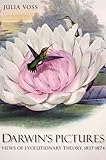This is my review of Darwin’s Pictures: Views of Evolutionary Theory, 1837-1874 by Julia Voss,Lori Lantz.
The eye-catching cover showing a pair of stylised hummingbirds on a water lily masks a well-translated from German if at times long-winded academic exploration of the evolutionary theory revealed in the pictures produced by Darwin and his contemporaries.
A prolific collector of specimens on his five year voyage on the Beagle, Darwin often lacked the knowledge to identify them correctly. So, it was the ornithologist Gould back in London who accurately classified the famous Galapagos finches with their distinctive beaks which provided early evidence for evolution, of which Gould himself ironically became an opponent, in the belief that such beautiful creatures as hummingbirds must have been designed by God.
Endearing in his shortcomings, Darwin failed to appreciate the importance of the locals' observation that the tortoises on each Galapagos island had a distinctive patterned shell. So, the creatures were taken aboard The Beagle for their meat and the shells discarded over the side. On his own admission a poor draughtsman, Darwin spent years back home constructing messy but ground-breaking diagrams to show evolution, such as the foldout chart from the 1859 Origin of Species, with neither origin nor end, but a focus on chance variation with the adaption and flourishing of some species at the expense of others. Unable to accept such vagueness, followers like Haeckel developed this idea into a clearly drawn tree culminating at the top with man, with gorilla, orangutan and gibbon on branches just below – a clear hierarchy which Darwin did not emphasise himself. It is fascinating to realise that gorillas were only being discovered by explorers at around the 1850s, so that the idea of humans somehow evolving from such a fearsome beast was hard to take in a society brought up to believe that man had been created by God only a few thousands of years before.
Although not very assertive in speaking out against religious beliefs, Darwin was troubled by the influential Duke of Argyll's clam that the perfection of the peacock's tail could only be explained by the existence of a Creator. Through painstaking drawings of patterns on the "argus pheasants" tail feathers, Darwin convinced himself that not only could these patterns evolve, but this perfection itself was a myth.
This book could have been made more accessible for the general reader, but it was probably the author's prime and understandable aim to further her academic reputation. As it is, the book provides some fascinating information on not only evolution but also Victorians' attitudes towards their origins and also how emotions might be expressed by both them and the domestic animals they had increasingly begun to keep – another research topic pursued by the ever-inquisitive Darwin.
4 Stars
